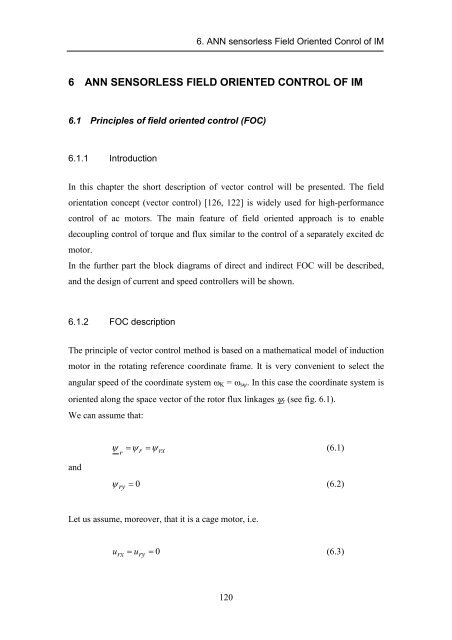POLITECHNIKA WARSZAWSKA
POLITECHNIKA WARSZAWSKA
POLITECHNIKA WARSZAWSKA
You also want an ePaper? Increase the reach of your titles
YUMPU automatically turns print PDFs into web optimized ePapers that Google loves.
6. ANN sensorless Field Oriented Conrol of IM<br />
6 ANN SENSORLESS FIELD ORIENTED CONTROL OF IM<br />
6.1 Principles of field oriented control (FOC)<br />
6.1.1 Introduction<br />
In this chapter the short description of vector control will be presented. The field<br />
orientation concept (vector control) [126, 122] is widely used for high-performance<br />
control of ac motors. The main feature of field oriented approach is to enable<br />
decoupling control of torque and flux similar to the control of a separately excited dc<br />
motor.<br />
In the further part the block diagrams of direct and indirect FOC will be described,<br />
and the design of current and speed controllers will be shown.<br />
6.1.2 FOC description<br />
The principle of vector control method is based on a mathematical model of induction<br />
motor in the rotating reference coordinate frame. It is very convenient to select the<br />
angular speed of the coordinate system ω K = ω sψ . In this case the coordinate system is<br />
oriented along the space vector of the rotor flux linkages ψ r (see fig. 6.1).<br />
We can assume that:<br />
and<br />
= ψ<br />
r r ψ rx<br />
(6.1)<br />
ψ =<br />
ψ = 0<br />
(6.2)<br />
ry<br />
Let us assume, moreover, that it is a cage motor, i.e.<br />
u u = 0<br />
(6.3)<br />
rx = ry<br />
120
















![[TCP] Opis układu - Instytut Sterowania i Elektroniki Przemysłowej ...](https://img.yumpu.com/23535443/1/184x260/tcp-opis-ukladu-instytut-sterowania-i-elektroniki-przemyslowej-.jpg?quality=85)
